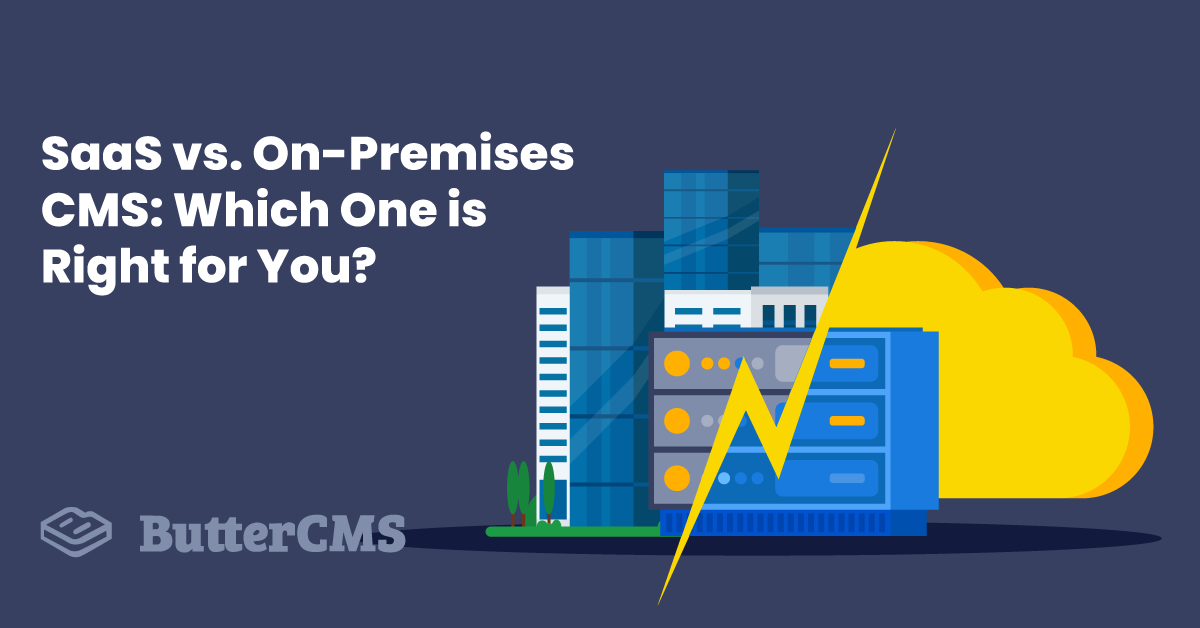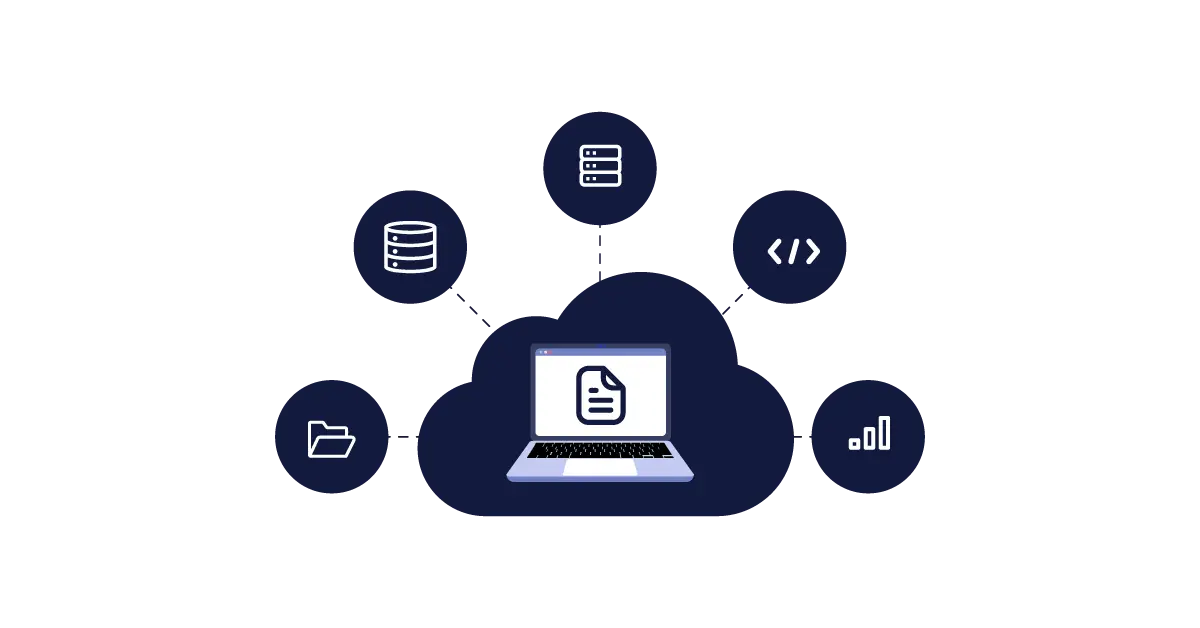
GSD
SaaS CMS vs. On-Premises CMS: Which One Is Right for You?
Posted by Hardik Shah on September 27, 2023
Today, if you're looking for a fitting content management system (CMS), various implementation options are available to choose from. And particularly with cloud-based and Software-as-a-Service (SaaS) models on the rise, one of your initial decisions—and a critical one—will be to choose between a SaaS CMS and on-premise CMS.
In this post, you'll learn the differences between a SaaS CMS and an On-Premise CMS, including some of their different subtypes such as Headless CMS (a.k.a API-based CMS). This article will also delve into the pros and cons of these two types of CMSs and discuss how to choose the right CMS for your business.
Table of contents
What is a SaaS CMS?
A SaaS CMS is a pre-built content management system that exists entirely in a cloud environment. It can typically be accessed online without installing, updating, or maintaining anything.
The SaaS vendor takes care of processes such as hardware setup, server management, storage, virtualization, and more. You also benefit from the vendor’s ongoing enhancements or improvements. You’d typically buy a license to use the SaaS CMS via a subscription. Some examples of SaaS CMSs are ButterCMS, Salesforce, and Box.net.
Types of SaaS CMSs
SaaS CMS are an excellent way to establish an online presence without having to pay a huge developer fees. Check out the different types:
- Open-source vs. closed-source: You can access an open-source CMS via the internet or download it at no initial cost. However, you may pay for customization, support, training, add-ons, plugins, etc. On the contrary, a closed-course CMS uses proprietary code and generally involves buying a license to use it or paying monthly/annual charges for support/updates. Examples of open-source: Kentico, Pulse CMS, and Joomla. Examples of closed-source: ButterCMS, Rivista, Haven Nexus, and Metro Publisher
- Legacy/Traditional CMS: Traditional content management systems have a technical architecture that tightly connects the frontend and the backend, providing everything from a database for content to a presentation layer for publishing.
- Hosted vs. On-premise CMS: A hosted CMS, similar to on-premise, is software you purchase with a license from a vendor however a hosted CMS is hosted remotely via a third-party hosting provider or rented through the vendor. Whereas for an on-premise CMS, you are responsible for all the infrastructure required to run the software. Essentially, with both options you own the software but with hosted, as the name suggests, you host it remotely rather than physically on-premises.
- Headless CMS: Another subset of SaaS CMS is headless CMS. A headless CMS is a back-end system that manages and organizes your content without a front-end layer. Let’s talk more about it below by using ButterCMS as an example.
Why is a Headless CMS a great choice?
A headless CMS relies on a modular architecture that decouples content creation and management from the front end. Simply put, it is a CMS with no front-end components, or “head”, to determine how content will be presented. Instead, it uses APIs to pull content from the backend, which can be published in rich formats on multiple channels. Thus, it enables:
- Quick and easy updates, integration, and scaling
- The latest tools and frameworks for developers to bring rich content experiences to any modern platform (including smartwatches, mobile devices, AR/VR, etc.) without being locked into a proprietary language or other limitations
- Control for marketers over website content creation, iteration, and publication without the need for developer assistance.
A great example of a headless CMS is ButterCMS. It is an API-based SaaS CMS that hosts and maintains an entire CMS platform without a “head”—meaning it only consists of a back-end, a CMS dashboard, and APIs to pull content into your front-end. As for the front-end, you can use any tech stack of your choice to create custom content models as it integrates with any tech stack due to its decoupled architecture.
Unlike traditional CMSs like WordPress, which have monolithic architectures, ButterCMS is a piece of software that only contains a backend. It provides easy to consume and performant content APIs that you add to your application for a connection, and it handles the rest. Moreover, using a headless CMS can help you reap the benefits of a static website (such as better security, scalability, speed, maintainability, and no infrastructure lock-in) made using an SSG or the Jamstack (JavaScript, API, Markup). Jamstack is a web architecture built on principles of pre-rendering and decoupling, resulting in a faster, more secure, and easier to scale websites. When using a jamstack architecture pre-rendered content is served via CDNs and dynamicity is enabled by using APIs and serverless functions.
Pros of SaaS CMS
Here are some benefits of using SaaS CMS platforms:
- No installation: A SaaS CMS is pre-built, working in production, and hosted in the cloud. If any installation work is required, the provider takes care of it. So you only need to sign up, pay the monthly fee, and then you can start using the CMS right away.
- No maintenance or upkeep: The CMS provider does all the maintenance work such as fixing bugs, maintaining infrastructure, providing support, etc., and continuously upgrades the CMS platform, which leaves your IT staff unburdened.
- Lower costs due to a pay-as-you-go model: SaaS providers typically offer monthly subscription plans. Thus, instead of paying a big upfront licensing fee, you pay each month that you use the CMS, which can lower costs substantially.
- Feature-rich: Because an SaaS platform has multiple customers, it is designed to be user-friendly, intuitive, and has many features to help drive your online business. Moreover, the provider constantly releases new features due to loads of user feedback, some of which you may not even realize you need.
- Scalability: Since SaaS CMSs are usually hosted in the cloud, they can scale seamlessly with your demand. A sudden burst of traffic won’t take your site down as the SaaS provider automatically performs horizontal and vertical scaling, and your IT team does not have to worry about handling servers. (Horizontal scaling refers to adding more instances to your pool of resources in the cloud and vertical scaling means adding more power to your existing instances/machines in the cloud).
- Service Level Agreements (SLA): Most SaaS CMS vendors offer a minimum uptime promise, backup, and redundancy plans. So in case of a crash, your developers do not have to worry about recovering lost data, and your users will not experience downtime.
Cons of SaaS CMS
However, there can be some potential pitfalls of going with a SaaS CMS:
- Lack of customization: Some SaaS solutions do not allow for advanced customizations as you have no access to the code. Thus, you cannot dramatically change how the core application works to suit your needs.
- Lack of control over security: With a SaaS CMS, you give away your security to a third party. Not many businesses may face this issue, but it can be a concern for companies dealing with sensitive data.
- Technology dependency: Most traditional or legacy CMSs like WordPress, though reliable if you need to quickly spin up a simple website, have a tightly coupled front and backend. This unfortunately means if you need or want to make substantial changes to your site you’ll need to know a specific language such as PHP in the case of WordPress or potentially some other proprietary information.That said, this issue can be avoided by using a Headless or Decoupled CMS.
- SaaS vendor lock-in: A major pitfall of SaaS solutions is the possibility of falling into vendor lock-in. It can occur when an enterprise becomes overly invested in the proprietary technologies of a software vendor.
What is an On-premise CMS?
An on-premise CMS is installed, hosted, and run locally on the organization’s in-house hardware. It requires companies to buy or rent hardware and put an IT team in place for administration. The IT team is responsible for updates, maintenance, upgrades, and implementations on the individual hardware. The organization has to bear all the costs of infrastructure, databases, and development resources.
Types of On-premise CMSs
All on-premise CMSs are hosted on web servers that you own or control, which happens in two ways:
- Self-hosted: On-premise CMSs are installed and run on infrastructure and servers that you own and have placed physically at your organization. You also need to manage and maintain all the hardware at your own cost and time.
- Homebrew/Custom CMS: Homebrew CMSs are custom CMSs designed and built by organizations, typically from scratch, to meet their specific needs.
Pros of On-premise CMS
Here are some benefits of using on-premise CMS platforms:
- More internal control: You decide the infrastructure and environment to install for your CMS, which gives you more control over how the CMS operates and functions.
- Quick updates: With an on-premise CMS, you do not need to wait for a CMS provider to add updates. Your on-site developer can push updates quickly and when required, such as during peak traffic scenarios.
- Customization: Since you are entirely responsible for running CMS on-premise and utilizing internal resources, you may find it easier to get the CMS fit your requirements even if you're working with a licensed solution. That said the option with the most customization will ultimately be an on-premise homebrew solution.
- Data protection: With an on-premise CMS, you retain all data in your own data centers. Third parties do not have any access to the data, giving you control over your data security. Moreover, it makes compliance with statutory data protection regulations easier because cloud servers can sometimes be located in countries with different data protection rules.
- Enhanced integration: Since an on-premise CMS is integrated deeper into your infrastructure, it can be easily interlinked with your other tools/programs (e.g., your marketing automation system, CRM, ERP and more).
Cons of On-premise CMS
As with SaaS CMSs, there can be some potential disadvantages of choosing an on-premise CMS:
- High maintenance, installation, and upkeep: Your IT team is responsible for supporting the on-premise CMS, which can radically increase the deployment times, upfront costs, and might even require hiring additional personnel.
- Lack of support: There will be a lack of support if the CMS manufacturer that you purchased the software license from discontinues the service or phases it out.
- Scalability: Unlike a SaaS CMS, the scalability of an on-premise CMS depends entirely on the underlying infrastructure. Maintaining in-house infrastructure can adversely impact scalability, especially if you don’t take advantage of the cloud.
- High costs: Besides the license fee, you also have to incur additional costs for installing, maintaining, and supporting the infrastructure and IT of an on-premise CMS.
How to choose the right CMS?
Choosing a suitable CMS for your website is one of your company's most important decisions. It provides the framework and functionality for web design and development and how your organization will grow and thrive online. Here are some aspects you must consider when choosing a CMS:
- Scalability: If a CMS can't grow with your business, is it an effective solution? You should consider a CMS solution that meets your scalability demands and handles fluctuations while maintaining a high level of service.
- Fitting the needs of your team: Does the CMS fulfill the needs of all the teams involved who access the CMS? The right CMS will address dynamic needs such as user experience for marketers, technical aspects the developers have to deal with, and workflows carried out by cross-functional teams like customer service and sales. For instance, there is no use in a CMS that provides fantastic DX but has no dashboard and therefore can’t be used by the marketing team to create and publish content.
- Ease of implementation and use: The speed and ease at which a CMS solution is implemented can help businesses launch new content initiatives and pages faster and more efficiently. Whereas a solution that requires a lot of resources to operate may leave an enterprise with a competitive disadvantage such as reduced time to market due to delayed implementation, page creation, and publishing.
- Customizability: You must also consider the amount of customization your business will need. Then, choose a CMS that allows you to customize the platform to meet your needs and not only use the features it comes with.
- Security: Security is another significant consideration. You want a CMS that will keep your content and customer data secure against current and future threats.
When to choose a SaaS CMS
If your website isn’t overly complex and you’d either rather not have to worry about uptime, support, and maintenance or don’t have the resources to allocate to these things indefinitely then going with a SaaS solution will probably be your best bet.
In addition to that, if getting your digital experiences live and online as quickly as possible is a priority for you then you should go with a SaaS solution. Furthermore the same goes for if you want to be able to readily take advantage of modern web architectures such as jamstack, emerging technologies such as Remix, or simply the ability to scale quickly.
When to choose an On-premise CMS
Large businesses with complex needs that go beyond the typical offerings of SaaS CMS providers may have more success when opting for on-premise CMS if they have sufficient personnel and expertise to handle its requirements as it gives more control over the CMS. We cannot stress this enough, not having the proper resources to keep your CMS up to date and secure will outweigh any customization benefits.
It is also preferable to opt for an on-premise CMS if a business’ existing hardware is already well-suited to meet its requirements or if the business is a data-sensitive organization. For instance, industries like financial services and healthcare are subject to strict data protection regulations and thus require a CMS that protects effectively from unauthorized third-party data access.
Conclusion
The SaaS development market will only continue to grow as more enterprises move to cloud-based solutions for better business efficiency. But, of course, on-premise solutions will also continue to be relevant under certain circumstances. When it comes to deciding on a CMS solution for your business, the choice between SaaS vs. on-premise will ultimately come down to your specific business needs and goals.
If your business has complex site requirements and you need a high level of customization and data control—or are beholden to strict industry security standards—then an on-premise CMS may be the best option for you. However, if this is not the case then chances are you’ll do just fine with a SaaS solution.
That said, if you're seeking to switch to a SaaS CMS, opting for a headless API-based CMS like ButterCMS is great if you intend to serve your content to customers on any device or platform by creating optimized digital experiences!
If you want your product or marketing team to test ButterCMS. We can set up a live demo to walk your team through the fast, easy-to-use interface.
ButterCMS is the #1 rated Headless CMS
Related articles
Don’t miss a single post
Get our latest articles, stay updated!
















Hardik Shah is a Tech Consultant at Simform, a leading web app development company. He leads large scale mobility programs that cover platforms, solutions, governance, standardization, and best practices. Connect with him to discuss the best practices of software methodologies @hsshah_.